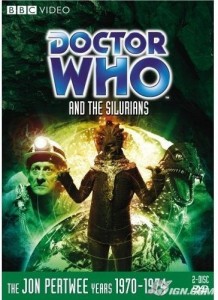 Welcome to the Twenty-sixth Instalment of Who Review. This week, the Pertwee era continues and new recurring villains make their first appearance in Doctor Who and the Silurians.
Welcome to the Twenty-sixth Instalment of Who Review. This week, the Pertwee era continues and new recurring villains make their first appearance in Doctor Who and the Silurians.
EPISODES
Doctor Who and the Silurians (7 Episodes)
BROADCAST DATES
31 January – 14 March 1970
THE DOCTOR
Jon Pertwee
THE COMPANIONS
Liz Shaw
THE EPISODES
The Doctor and Liz are summoned to an experimental nuclear power research centre built into a network of caves in Wenley Moor by Brigadier Lethbridge-Stewart. UNIT have been called to the site because of the death of a technician in the caves, as well as unexplained energy drains that have been plaguing the project and the high incidence of mental breakdown amongst its members.
Arriving at the facility, the Doctor and Liz are briefed by the Brigadier and their investigation begins. It soon becomes apparent that some external force is causing the power drains, a force that is also affecting the minds of the technicians and scientists at the plant.
Exploring the caves below, the Doctor discovers a prehistoric lizard terrorising the area. The creature is seemingly controlled by the denizens of the caves, intelligent bipedal beings. One such creature is shot by UNIT soldiers and forced to flee above ground, leading to a desperate search by the Doctor and his associates.
After a lengthy investigation, The Doctor and UNIT discover the existence of the Silurians, an ancient alien race that has existed in suspended animation under the Earth for millions of years. The Silurians were once rulers of the Earth, but when their scientists detected an approaching planet on a collision course with our own, they placed themselves in suspended animation in the underground caverns to avoid destruction should the planets collide. Little did they know that the planet was trapped by Earth’s gravitational pull. Rather than colliding with the Earth, the celestial body became our moon.
Unfortunately, the Silurian technology malfunctioned, leaving the aliens imprisoned until a new power source could reactivate the machines. This energy was provided by the nuclear testing base, revitalising the aliens. Each subsequent power drain was the result of the Silurians awakening more of their race.
Believing the Silurians to be a potential threat to humanity, the Brigadier plans a systemic assault on the caves. The Doctor, however, believes that the Silurians are a peaceful race, and hopes to broker peace between them and humanity.
The Silurians, for their part, perceive humanity to be usurpers who have no claim to Earth. Their initial plans are to destroy humanity, but the Doctor is able to convince the Silurian leader to broker a peace deal. Unfortunately, the leader is betrayed by member of his own race who believe he is showing signs of weakness and may be betraying him to the humans. They kill him and unleash a deadly virus that threatens to destroy humanity. The virus quickly spreads to London.
Working tirelessly, the Doctor manages to develop an antidote, even as those around him succumb to the effects of the virus. Unfortunately, he is kidnapped by the new Silurian leader, but not before he has written out most of the formula for the antidote. Liz manages to pass the formula onto the appropriate scientists in London and despite some casualties, humanity is saved.
The Silurians, meanwhile, have developed a new plan; they will use the nuclear reactor and their own technology to destroy the Van Allen Belt around the Earth. Once the belt is destroyed, the rising temperatures and harsh rays of the sun will destroy humanity, but the reptilian aliens will thrive in the new conditions.
Seizing control of the facility, the Silurians coerce the Doctor into aiding in their new plan, but he and Liz stage a nuclear meltdown instead. Fearing for their lives, the Silurians retreat to their suspended animation chambers, where they will sleep for 50 years until the radiation is dispersed. Only the new Silurian leader remains, to ensure that the rest of his race is safely returned to hibernation.
Before the reactor can overload, the Doctor and Liz manage to shut it down, saving the facility and all within. The Doctor then ventures down into the caves again, hoping to reopen peace talks with the Silurian leader. Instead, the alien attacks him. Before he can kill the Doctor, he is shot by the Brigadier.
With the crisis averted, the Doctor hopes to reawaken the Siluriansone by one and broker a lasting peace between the races. In order to do so, he will need additional equipment, and begins the journey to London to retrieve the items he needs. Once he is gone, the Brigadier detonates a series of explosives that buries the Silurian base, so that the aliens will never escape or threaten humanity again.
The Doctor is horrified by this act of genocide. Liz tries to calm him by suggesting that the Silurians would never have agreed to a peaceful compromise, but The Doctor remains disgusted by the Brigadier’s actions.
MY THOUGHTS
Doctor Who and the Silurians opens with an effective and intriguing mystery that evolves into an epic struggle for supremacy between humans and aliens. There is a slow build as the Doctor and his associates unravel the mysteries of the caves and discover the existence of the Silurians, leading to a cycle of escalating hostilities between the races.
As the threat of the Silurians increases, so too does the strong social and psychological commentary on the nature of humanity that lies at the heart of the story. Both the humans and the Silurians are quick to resort to violence and warmongering, despite the Doctor’s attempts to broker peace between the races. Both sides suffer from paranoia, perceiving the other as a threat and preaching destruction and genocide. Whenever a peaceful solution presents itself, it is derailed and destroyed by those unable to see past their own preconceived prejudices.
This is a telling message reflecting the era in which the story was written, clearly influenced by the Viet Nam War that was raging at the time. However, it is a message that is equally relevant today and screenwriter Malcolm Hulke captures the conflicting sides of humanity brilliantly.
Hulke was initially reluctant to write for the series, feeling that the nature of the show limited his writing to alien invasion or mad scientist stories. He developed the Silurians as a race that had ruled Earth before humanity in order to overcome this, and it’s fortunate that he did, as The Silurians is one of the standout Who storylines.
My only real complaint is that, at seven episodes, The Siluriansis a little too long and would have benefitted from some editing. The penultimate chapter is especially telling in this regard and feels more like padding than progression.
Fans of classic British SF series Blake’s 7 will be interested to note the presence of actor Paul Darrow as Captain Hawkins of UNIT in this storyline, eight years before his career-defining role as Kerr Avon. Watching Darrow here had me imagining just how cool a Doctor/Avon crossover would have been.
The Silurians marks the first appearance of Bessie, the Doctor’s vintage canary yellow roadster. This vehicle would become synonymous with the Pertwee era.
The spread of the virus in London features scenes shot at Marylebone Station. These scenes feature cameos from script editor Terence Dicks, producer Barry Letts and assistant script editor Trevor Ray.
THE DOCTOR
Jon Pertwee continues to make the role of The Doctor his own, establishing his own distinct personality and mannerisms. Certain traits remain from the Troughton and Hartnell eras, most prominently the Doctor’s extreme intelligence and resourcefulness, but Pertwee brings a new and very distinct approach even to these traits.
He is bolder, more boisterous and more confident that his predecessors, and continues to bring perfect comedic timing and wry wit to the role.
THE COMPANIONS
Brigadier Lethbridge-Stewart is the straight man to Pertwee’s Doctor, and actor Nicholas Courtney’s very staunch, very British performance is the perfect counterpoint to Pertwee’s wry humour. They play off one another beautifully, adding a strong dynamic and wonderful chemistry to the series.
However, the Brigadier’s destruction of the Silurians at the end of the storyline not only reinforces the social message of the story but also shows a darker side to his personality; he will do whatever it takes to protect humanity, including blatantly lying to the Doctor and committing acts of genocide.
Unfortunately, Liz Shaw is the weak link in this season. She is by no means a bad character, but she is completely overshadowed by both the Doctor and the Brigadier. She has occasional moments to shine in The Silurians, but not enough to make her really stand out as a strong character or a strong companion.
THE VILLAINS
The Silurians are one of the more interesting Doctor Who races, especially in how closely they mimic their human adversaries. In many SF shows, Doctor Who included, villainous alien races are often single minded and unified in their goals. The Silurian’s, however, ran the full gamut of emotions, from the level-headed Silurian leader who brokers for peace to his paranoid, genocidal second-in-command who attempts to destroy humanity but also sacrifices himself to save his race. The Silurians are shown to be all-too human emotionally and are even sympathetic. It’s a refreshing change from the single-minded destructiveness of the Daleks, Cybermen and others.
The idea of an ancient civilisation sleeping for millennia beneath the Earth is a classic of SF and one that greatly appeals to me. I also love the open-endedness of the Silurian story, with the race still buried in suspended animation within the caves, ready to awaken and threaten humanity again one day.
The Silurians are never given an official racial name during this storyline. The Doctor dubs them “Silurians” as he believes they may have ruled Earth during the Silurian Era, although reptilian life had not developed on Earth during that period, so the name is a misnomer.
FINAL THOUGHTS
Although Doctor Who and the Silurians may be a little long, it is still an excellent story with a powerful social message and excellent character development.
4 Lukes
NEXT
Unfortunately the next storyline, The Ambassadors of Death, won’t be released on DVD until October. Fortunately, friend of Who Review and Doctor Who fanatic Melthoid has kindly provided me with a video copy of the story, so we’re good to go if I can dig out my old VCR in time...









Definitely the best story of Pertwee’s first season (despite the sensational ‘novelty’ of Inferno)…I love this story and agree with you re the padding of the 6th episode, although some excuses could be made. Dr Who at the time was a 25 minute weekly serial. It’s probably only noticeable that it’s padded when you watch in a block. Being the first season brought standard BBC budgetary constraints as well…it was far better to have 7 episodes of the Silurians than an extra episode of Ambassadors of Death, probably the weakest story of the season. It’s wonderful to see the Silurians in colour for the first time…during the seventies and eighties when the used to repeat Pertwee/Baker episodes often, they’d often skip the black and white episodes even if it meant chopping up certain stories…for example they always showed Planet of the Daleks and Invasion of the Dinosaurs without the episodes they only had in black and white. The latter was often shown starting at episode 2! Thankfully this policy was later abandoned and the Pertwee era began to be shown in its entirety. Speaking of Invasion, the only dud part of the Silurians was the awful Dinosaur ‘guard dog’ that the Silurians kept…it should’ve been a forewarning NOT to do Invasion of the Dinosaurs…sadly no one at the BBC was paying any attention
You bring up an interesting point about the padding being more noticable on DVD. It’s easy to forget that episodes were aired weekly during the initial broadcasts. Even as a younster I remember Who being on 5 nights a week, so i never got to experience the once a week phenomenon. I’m sure the padding wouldn’t be as noticable in its original broadcasting format.
I can only imagine how confusing it must have been watching stories with missing episodes. Even watching Ambassadors of Death on video it’s clear the ABC has cut out or shortened some scenes, probably for censorship reasons, but the cuts are obvious and a little jarring.
I kind of like the guardian dinosaur. Sure, he’s hokey, but this is Doctor Who.
I didn’t realise the Silurians had appeared before the 11th doctor. This is great!
Long though it may be, it sounds like it was a far better story than the Matt Smith episode.
I found that one of the weaker episodes of the later Dr. Who series.
The Silurians actually made 2 appearances in the original series. Their second came 14 years after this one, in the Peter Davison storyline “Warriors of the Deep”.
Later on in the Pertwee era, we also see “The Sea Devils”, who are described as aquatic cousins to the Silurians. The Sea Devils also appear in “Warriors of the Deep.”